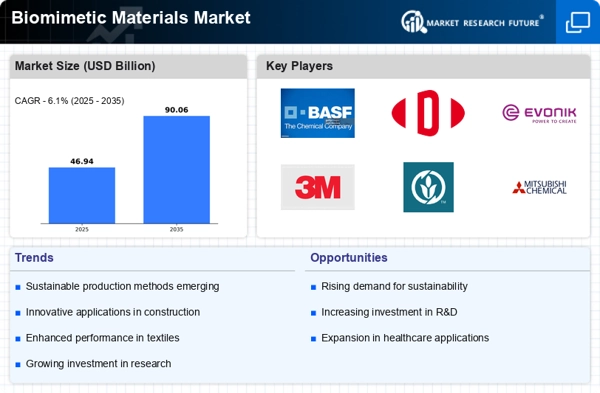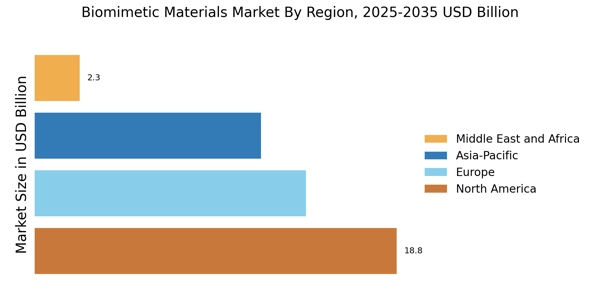Regulatory Support
Regulatory frameworks promoting sustainable practices are emerging as a significant driver for the Biomimetic Materials Market. Governments are increasingly implementing policies that encourage the use of environmentally friendly materials, which aligns with the principles of biomimicry. For instance, regulations aimed at reducing plastic waste and promoting biodegradable alternatives are fostering a favorable environment for biomimetic innovations. This regulatory support not only incentivizes research and development but also enhances market accessibility for companies specializing in biomimetic materials. As a result, the Biomimetic Materials Market is likely to experience accelerated growth, as businesses adapt to comply with these regulations while simultaneously meeting consumer demand for sustainable products.
Diverse Application Areas
The versatility of biomimetic materials is a crucial driver for the Biomimetic Materials Market. These materials find applications across a multitude of sectors, including aerospace, automotive, and healthcare. For example, in the aerospace industry, biomimetic designs are utilized to create lightweight yet durable components, enhancing fuel efficiency. In healthcare, materials that mimic biological structures are being developed for use in prosthetics and tissue engineering. This broad applicability is reflected in the market's anticipated growth, with estimates suggesting a compound annual growth rate of around 12% over the next five years. As industries increasingly recognize the benefits of biomimetic materials, the Biomimetic Materials Market is poised for expansion, driven by the demand for innovative solutions that address specific challenges.
Technological Innovations
Technological advancements are significantly influencing the Biomimetic Materials Market. Innovations in material science, such as 3D printing and nanotechnology, are enabling the development of sophisticated biomimetic materials that replicate the properties of natural substances. For instance, the ability to create materials that mimic the self-cleaning properties of lotus leaves or the structural integrity of spider silk is revolutionizing applications in sectors like construction and healthcare. The market is projected to reach a valuation of over 10 billion by 2027, driven by these technological breakthroughs. As research continues to unveil new possibilities, the Biomimetic Materials Market is likely to witness an influx of novel products that enhance efficiency and performance, thereby attracting investment and interest from various industries.
Sustainability Initiatives
The increasing emphasis on sustainability appears to be a pivotal driver for the Biomimetic Materials Market. As industries strive to reduce their environmental footprint, biomimetic materials, which often utilize renewable resources and mimic natural processes, are gaining traction. This shift is evidenced by a projected growth rate of approximately 15% annually in the sector, as companies seek eco-friendly alternatives to traditional materials. The integration of biomimetic designs not only enhances product performance but also aligns with corporate social responsibility goals. Consequently, businesses are increasingly investing in research and development to innovate sustainable solutions, thereby propelling the Biomimetic Materials Market forward. This trend suggests a long-term commitment to environmentally conscious practices, which may redefine material selection across various sectors.
Consumer Awareness and Demand
Growing consumer awareness regarding environmental issues is driving demand for biomimetic materials within the Biomimetic Materials Market. As consumers become more informed about the impact of their choices on the environment, there is a noticeable shift towards products that are sustainable and ethically produced. This trend is prompting manufacturers to incorporate biomimetic materials into their offerings, as they align with consumer preferences for eco-friendly solutions. Market Research Future indicates that approximately 70% of consumers are willing to pay a premium for sustainable products, which is likely to encourage further investment in biomimetic technologies. Consequently, the Biomimetic Materials Market is expected to thrive as businesses respond to this heightened demand, fostering innovation and expanding product lines.


















Leave a Comment